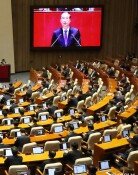16 years of frozen college tuition fees lead to talent drain
16 years of frozen college tuition fees lead to talent drain
Posted August. 09, 2024 07:40,
Updated August. 09, 2024 07:40
After 16 years of a tuition fee freeze, cash-strapped universities are struggling to find professors, which is disrupting the management of academic affairs. One university that sought to hire a full-time professor to teach secondary batteries had to re-post the position after receiving no applicants due to the low salary. Companies and overseas universities are competing for talent in fields such as artificial intelligence (AI) and semiconductors, offering high salaries. Even for non-STEM majors, domestic universities are facing a chronic shortage of professors, as the salary gap with overseas institutions has widened by five to six times. While universities around the world are fiercely competing to attract top talent, domestic universities are facing a crisis of ‘talent hollowing.’
This year, the average tuition fee per student is 6.827 million won, which is cheaper than English kindergartens and dog daycares. Since implementing the half-price tuition fee policy in 2009, university tuition has remained flat, while consumer prices have risen by 33%. As universities tighten their belts, lab fees, book purchase funds, and faculty research budgets have been cut in half. Students are being taught in lecture halls where rainwater is caught in buckets, and research is conducted in labs that are in worse condition than those in high schools. Students are now in a situation where they are demanding higher tuition to fix the restrooms. Many universities have canceled their subscriptions to major international journals. When you can't even find professors to teach, it’s not just that higher education has become less competitive; it has lost its function altogether.
This year, the statutory cap on tuition increases is 5.64 percent. Essentially, tuition can be raised by no more than 1.5 times the rate of consumer price inflation, but no university can afford to do so, as raising tuition limits access to state scholarships and penalizes financial aid programs. Tied down by regulations and pressured to survive, universities are forced to become dependent on the government.
When Lee Ju-ho took office as deputy prime minister and education minister, the ministry made waves by abolishing the Office of Higher Education Policy and promising to loosen university regulations. However, the practice of using financial support to prevent tuition increases, even within the legal range, has not changed. The National Assembly Research Service has pointed out the illegality of indexing state scholarships to tuition increase rates and recommended that the practice be abolished. How long should the goal of college education be providing "half-price" tuition to ease the burden on families, especially when this goal is driven by political motives? Before it's too late, the Education Ministry must repeal this illegal regulation, make tuition more realistic, and allow universities to increase their competitiveness on their own terms and focus on training future talent.







